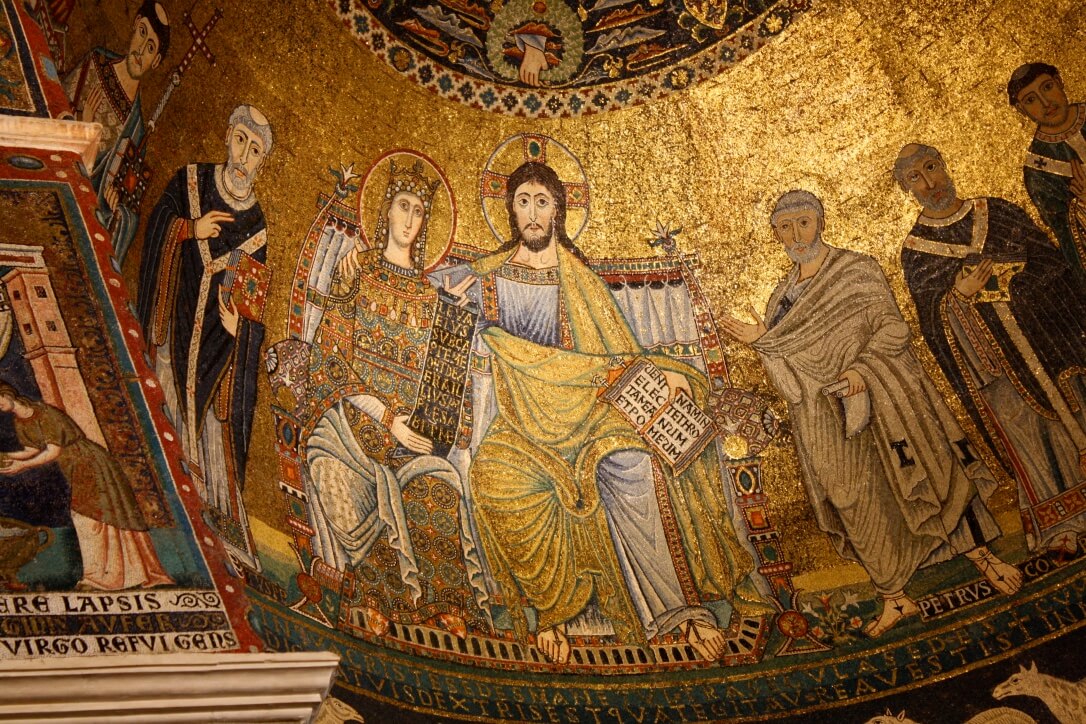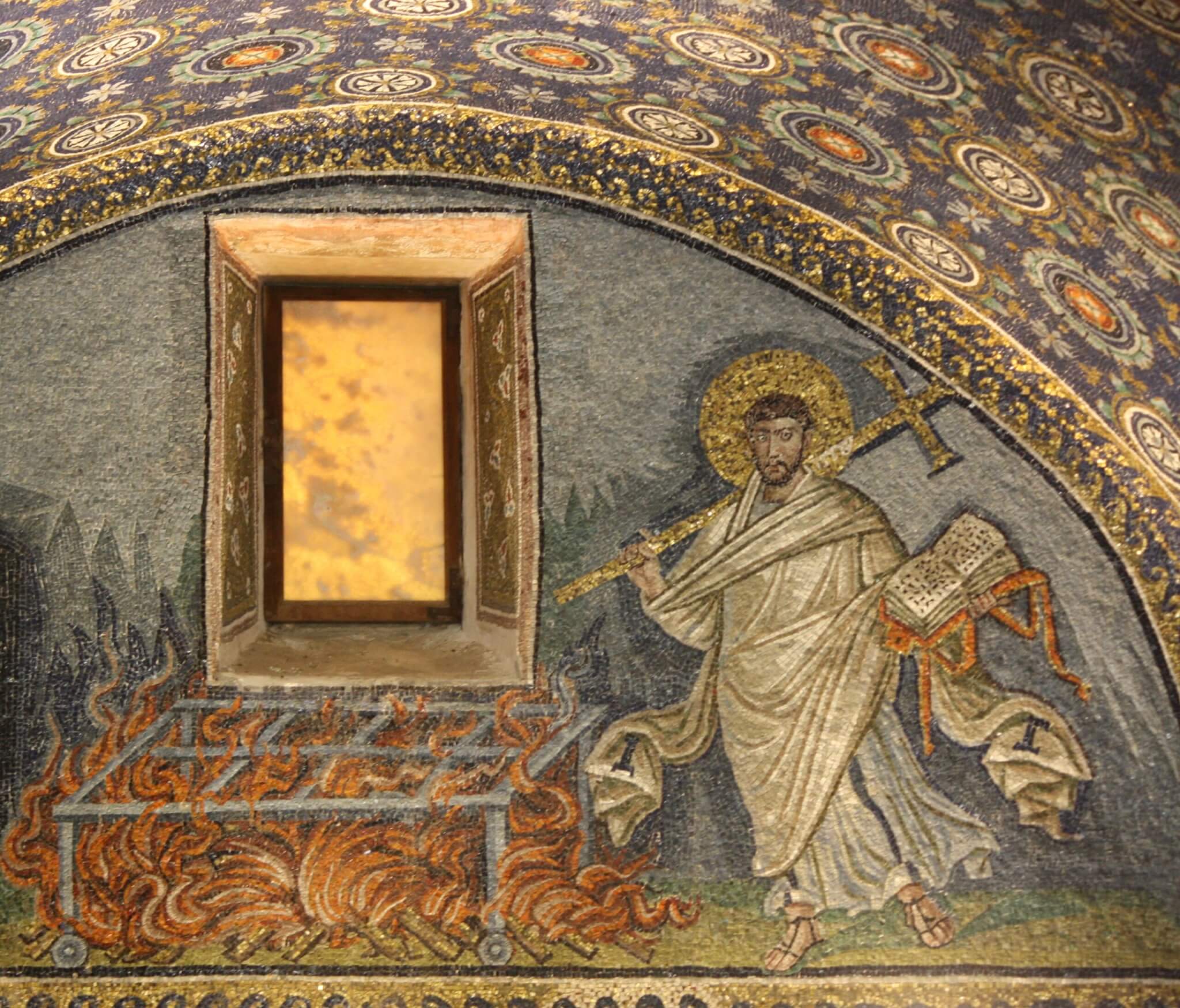The law of praying (5): Communicating with the Saints
Over the summer, we are looking at a section from the Canon of the Mass each week, to learn what the ‘law of praying’ has to teach us about what we believe. You can find the previous posts in this series in our reflections archive.

In communion with those whose memory we venerate,
especially the glorious ever-Virgin Mary,
Mother of our God and Lord, Jesus Christ,
and blessed Joseph, her Spouse
your blessed Apostles and Martyrs,
Peter and Paul, Andrew,
James, John,
Thomas, James, Philip,
Bartholomew, Matthew,
Simon and Jude;
Linus, Cletus, Clement, Sixtus,
Cornelius, Cyprian,
Lawrence, Chrysogonus,
John and Paul,
Cosmas and Damian
and all your Saints;
we ask that through their merits and prayers,
in all things we may be defended
by your protecting help.
Through Christ our Lord. Amen.
This is meant to be a spiritual commentary on the Canon of the Mass, rather than a grammatical one. However, in approaching this section, we have to point out the oddity that all other commentators point to first. ‘In communion with’ — well, that’s a tidied-up translation of the Latin original. ‘Being in communion with’ might be a more literal translation of communicantes. But you can’t make a complete sentence out of that form of the verb. (‘I kicking a ball’ doesn’t make a complete sentence in English or in Latin.) Where has the rest of this sentence gone?
The answer is that it was interrupted by the previous paragraph. How that happened doesn’t really matter. We are, in fact, continuing the sentence and the thought of the prayer for the Church we looked at two weeks ago. Recall that we prayed for the Church — that Church we know we are in communion with because we are in communion with the Pope and our Bishop, both of whom we named. In fact, we effectively presented our credentials. By naming our Pope and our Bishop, we showed God our membership card that proves we are members of his Church.
And now that we know we are members of the Church on earth, that must also mean we are in communion with the Church in heaven. So having presented our credentials to the Father in the earlier section, we now reap the benefits and invoke the protection of the saints in heaven. The act of standing at the foot of the Cross and presenting a list of demands to God should be a terrifying one. Thankfully, it is not — because we trust that God is our loving Father. But just in case we had any doubt, he also gives us the support of his — and our — friends in heaven.
Our Lady comes first of course. She occupies the first place in heaven next to her Son — never let anyone tell you that the Catholic Church doesn’t respect women. We also express two of the four Marian dogmas here: that she is ever-virgin and Mother of God. A dogma is a teaching so fundamental to the faith that you have to believe it in order to be a real Christian. The divinity of Christ, for example, is clearly a dogma of the faith. If you don’t believe Jesus is God, then whatever else you might believe that is correct, you haven’t really got the fundamental idea of Christianity. The teaching that Mary is ‘Mother of God’ is something we must believe, because she is the Mother of Jesus. If we say that she is not Mother of God, we must be saying that her child is not really God. And then we’re really in trouble. So we are reminded of this seeming paradox, this wonderful miracle, brought about through the overshadowing of the Holy Spirit: the Incarnation. The Word was made flesh, and dwelt among us.
Also occupying prime positions in this list of saints are the princes of the Apostles, Peter and Paul, so central to the faith of the Roman Church, and the remaining Apostles follow after. (Paul fills in the gap here left by Judas Iscariot. Judas’ replacement, St Matthias, appears later.) But then some saints follow who might be less familiar. They are all martyrs, as we are told, but how and why are these particular martyrs chosen?
Linus is the second Pope. He is St Peter’s immediate successor as Bishop of Rome, and appears in St Paul’s writings (2 Timothy 4:21). Cletus is the third Pope, Linus’ successor. Clement is number four, and also appears in scripture (Philippians 4:3). That shows us they were known to the Apostles, and were part of their generation. And that in turn shows us how quickly the Romans got through Popes in the early years of the Church.
Can you guess who Sixtus was? That’s right. He is of course the twenty-fourth Pope. Not the fifth as you might have expected, nor the sixth as the name might suggest. (‘Sixtus’ is our spelling of the Greek name Xystus, and has nothing to do with the number ‘six’. Though there was a St Sixtus I who was Pope number seven, just to really confuse things.) The Sixtus we mention here is the second Pope of that name, and lived in the third century.
Cornelius is the last Pope in the list, then we get some other people the Romans just liked. Cyprian was a heroic bishop of Carthage and Father of the Church. Lawrence was an extremely popular deacon in Rome — his church is still today one of the seven principal churches of Rome. His popularity might be down to his generosity to the poor of Rome, or his sense of humour. Lawrence was in charge of administering the Roman Church’s finances. When persecution broke out, Roman soldiers were sent to him to collect the vast wealth of the Church. Lawrence told them he would happily hand it over, but that it was so great that it would take him a day to gather it all. Could they come back tomorrow? During which time, Lawrence took what money there was and distributed it to the poor. When the soldiers returned, they found his rooms packed with all those Lawrence had helped. ‘Behold the treasure of the Church!’ he said to them. It didn’t go down too well. Lawrence was sentenced to death by roasting on a gridiron. Halfway through his martyrdom, he called out cheerfully to his executioners, ‘You can turn me over — I’m done on this side.’ No wonder he has always been so popular with the Roman people.

Almost all of these saints are buried in Rome, with churches built over their bodies. St Philip used to say that when we find ourselves unable to pray, we should walk round the altars of the saints and beg their prayers as a spiritual alms. In Rome, this means more than simply visiting an altar dedicated to a saint with a painting or statue above it. In Rome, very often, the saint’s body itself is buried beneath the altar. To walk around the churches of Rome is to walk through the prayers of the Mass.
Most of these saints quite literally form the foundations of churches in Rome. All of them are building blocks of the Church that we know today. They played their part in handing down the Catholic faith as it has reached us through the Roman Church. It is because our faith — and especially our prayer — is so Roman that we can be certain that it is also Catholic. The catechism didn’t come to us directly from heaven. We each of us were taught the faith from others. The Gospel is not myth but history, and therefore it is transmitted to us through history, through real people. That’s what this list describes. We are tracing how the faith reached us: Peter passed it to Linus; Linus passed it to Cletus; Cletus to Clement... Sixtus… all the way down to us to us. We can trace our own Catholic faith back to these saints — who died witnessing to the truth of what they taught. And they in turn could trace their faith back to the Apostles, and through them, to Christ himself.

